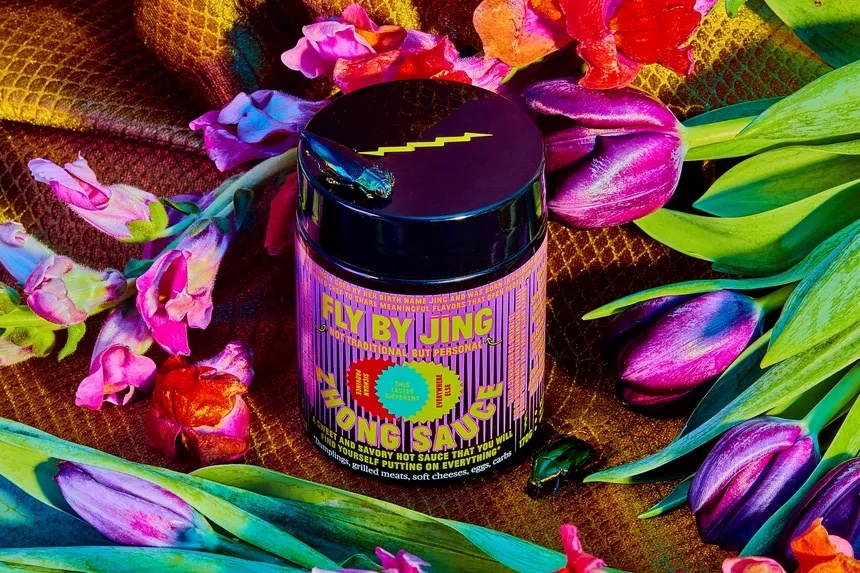

I even substituted the "Tribute Pepper Oil" and "Chili Pepper Oil" in Italian dishes that called for Calabrian chili oil, and was pleasantly invigorated with heat. In the span of time I've been sampling Fly By Jing's wares, I've used them to adorn steak and eggs, breakfast sandwiches, gyros, smoked fish, chicken, crab, and both grilled and sauteed vegetables.

I've been foisting the Zhong Sauce, Sichuan Chili Crisp, Mala Seasoning, and dumplings upon dinner guests for over two weeks. You not only taste each ingredient, you can dissect the dumpling and find, perhaps to your surprise, that it is largely unprocessed. They're on the pricey side compared with, say, your regular freezer-aisle potstickers, but they're a specialty of Gao's, and a step above the competition. The brand's dumplings - Pork, Shrimp, and Scallop Pork, Shrimp, and Mushroom and Pork Xiao Long Bao Soup Dumplings - are its newest addition. It is at once a sweet, herbaceous, and visceral indulgence start to finish, and hard to put down. The Mala spice is recognizeable as a more traditional Chinese seasoning (though Fly by Jing's is made with Gao's zeal for freshness) that can be used like a dry rub before or after cooking. Like any variation of the Chinese classic, it isn't for the faint of mouth, but the earthier, milder tones of the Zhong Sauce allow for a quick recovery of the senses. The highly spicy chili crisp, which Gao recommends for "ice cream, fried eggs, vegetables, and meat," and, again, "carbs," mounts a decidedly more brutal attack on the taste buds - although, that's not a bad thing. It holds its own beside the Sichuan Chili Crisp, and I made my way back and forth between the two before concluding that I am enamored with both and couldn't choose one or the other if I tried. Its Zhong Sauce, which offers a perplexingly delicate balance of sweetness, smokiness, and savoriness (if we may), is at home atop "dumplings, grilled meats, soft cheeses, eggs, and carbs," and more than once, I've found myself indulging in a level spoonful of the stuff. The brand's chili crisp recipe also calls for something called "semi-winter rampa, or rapeseed oil" - though Gao is quick to distinguish it from "European rapeseed or canola oil, as the FDA makes us write it." A yellow-flowering member of the mustard family, semi-winter rapeseed is sown before winter, flowers in spring, and tends to carry flavor rather than impart it, making it a choice vessel for Fly by Jing's complex condiments.įly By Jing's Chili Crisp was an instant hit, but the brand hasn't stopped there.

That's how highly those small, red seeds were (and continue to be) coveted. Painstakingly (and painfully) harvested by bare hand once annually from a small plot of land in Sichuan, the tribute pepper is so named because for 300 years, the village of QingXi - by many accounts the peppercorn's preeminent grower - made a point of expressing a portion of each harvest to China's imperial courts. Gao's highly personal take on Sichuan chili crisp - Fly by Jing's flagship product - involves 18 ingredients, some of which can only be found in China's Sichuan Province.įor obvious reasons, we couldn't exactly pry every little detail out of the proprietress, but she did say that the most essential ingredient is the peppercorn of the tribute pepper, or gongjiao, which Fly by Jing employs widely across its inventory. We spoke with the entrepreneur about launching a successful startup amidst a pandemic, how Fly by Jing went from a small operation to being sold at Whole Foods and Target stores nationwide, and what's next for the rising brand. Guests loved her chili crisp so much that she decided to bottle it and build a Kickstarter page. One thing lead to another, and Gao ended up quitting her tech job and opening a restaurant in Shanghai. "My hypothesis is that people were ready for a new paradigm." "I was realizing that so little real Chinese food made its way out of China and wanted to shine light on that, and represent it on a global stage," she told Insider. "There was an active prejudice against Chinese food as being dirty, cheap, and unhealthy."įirst and foremost, Gao wanted to grasp and address those perceptions for herself, and in the process, a company was born. "I wanted to shift the way people saw Chinese culture and food in the US," says Fly By Jing founder Jing Gao, who in 2018 launched one of Amazon's top-selling "hot sauces" (although that term doesn't quite do it justice), a personal take on Sichuan chili crisp.


 0 kommentar(er)
0 kommentar(er)
